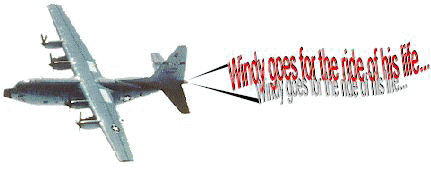

| There's no time to relax; the real work lies ahead. "We're almost there," declares the weather officer. "I see a calm spot ahead on the water," confirms the pilot. You notice that the air conditioning doesn't seem to be working so well anymore, then you remember hearing that the temperature is warmer inside the eye. Meanwhile, at the back of the plane, the dropsonde operator is busy loading the dropsonde into its launch tube, getting ready to drop the instrument into the exact center of Opal's eye. | 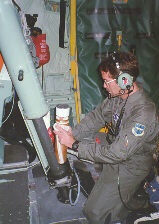 |
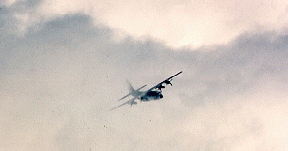 |
The weather officer watches intently as the wind speed dies off, then suddenly the wind shifts; instead of coming from the left, it's now coming from the right. "Fix it here!" shouts the weather officer, and the navigator marks our precise position--the exact center of the eye. There's a "ker-chunk" sound as the dropsonde ejects from the plane with a push of a button. "Sonde away," announces the dropsonde operator. Everyone is working furiously as the ominous wall cloud looms ever closer to our "tiny" airplane. |
| The navigator plots the position and compares it to the last fix from the Hurricane Hunter airplane that left Opal two and a half hours ago. "Opal is moving 030 degrees (north-northeast) at 7 knots (10 mph)," he informs the crew. The weather officer finishes typing up the last details on the Vortex Data Message, then with a few keystrokes, the critical information is sent via satellite to the National Hurricane Center. | 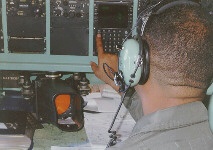 |
 |
We punch back into the eyewall and
plunge immediately into the darkness, rain, and turbulent air that we had left only a few
moments ago. But somehow it doesn't seem so bad this time (now that you're a veteran
Hurricane Hunter!). The dropsonde finally hits the water, and the dropsonde operator codes
up the information. His report: the sea-level pressure is 936 millibars. This surprises
the crew, since the last fix reported it as 948 millibars.! The weather officer explains
that a five millibar drop can be significant...but this is amazing!!! The news electrifies the forecasters in Miami; Opal is really intensifying! |
| You fly another 105 nautical miles away from the eye to measure the extent of damaging winds in that quadrant of the storm, then turn to intercept the next inbound leg in the "Alpha pattern", which looks like a giant "X" crossing the storm. Less than two hours after the last time you penetrated the eye, you're there again! In fact, you'll penetrate the eye a total of four times on this flight, until the next Hurricane Hunter airplane is on its way to take over. | 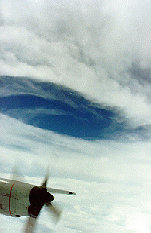 |
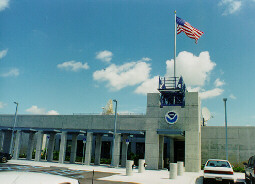 |
During the entire six hours you spend inside the storm, the hurricane specialists at the National Hurricane Center in Miami are flooded with weather data measured automatically by the aircraft every 30 seconds. Plugging this information into the NHC's computers can improve the forecast by up to 30%! The hurricane specialists are especially astounded by the drop windsonde data, which reveals the central pressure dropped an incredible 42 millibars in only 12 hours. Their new warnings prompt civil defense and other emergency managers across the Florida panhandle to speed up evacuations. |
| Back to Windy's Room | A "gift" to remember your trip by. |